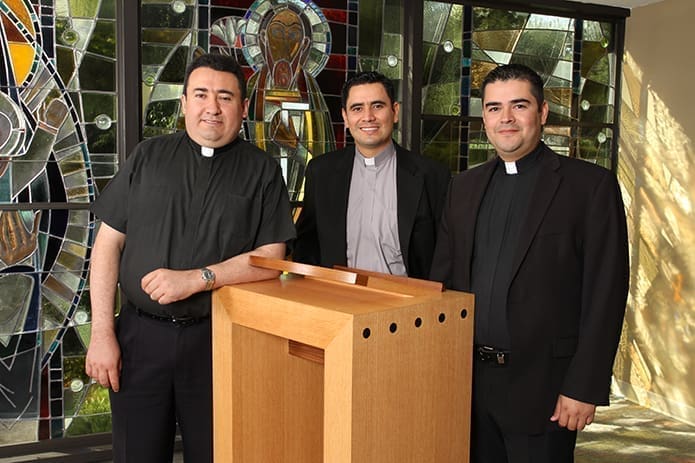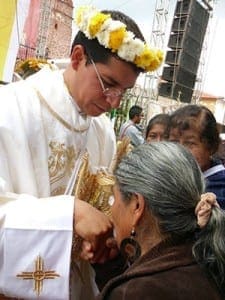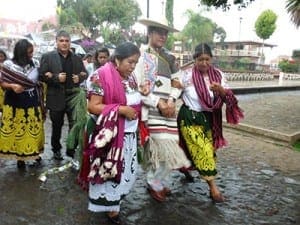 Photo By Michael Alexander
Photo By Michael AlexanderAtlanta
From Dalton to Morelia, priest’s ordination celebrated
By PRISCILLA GREEAR, Special To The Bulletin | Published October 24, 2013
ATLANTA—When Father Luis Simon Gallardo was ordained in August in Mexico, for his native diocese, there was fraternal joy and bittersweet rejoicing in the Atlanta Archdiocese.
In fact, he is a spiritual son of St. Joseph Church in Dalton. He initially longed to serve the immigrant Mexican community in Georgia.

A woman kisses the hand of Father Luis Simon Gallardo as he is welcomed to celebrate his first Mass in his home parish in Mexico Sept. 2.
“He discovered his vocation while being part of the very active youth group” at St. Joseph’s, said Msgr. Dan Stack, pastor in Cartersville.
A native of the Mexican state of Michoacan, Simon Gallardo arrived in Dalton in 1990 at the age of 19 and at St. Joseph’s became a youth and young adult leader, a lector, charismatic prayer group member and building fundraiser.
He was one of the leaders of a major Dalton event called the Cultural Expo, Msgr. Stack recalled.
“The group raised the money to rent the Dalton Convention Center and offer a daylong program highlighting the national origin of those living and working in Dalton. This was done as a response to a summer-long anti-immigrant ‘letter to the editor’ campaign in 1997. More than a thousand people came to the convention center to see fixed exhibits, sample regional foods and see folk dances and hear ethnic music. At the end of the day Mass was celebrated in honor of Our Lady of Guadalupe. This event was held in 1997 and 1998,” Msgr. Stack said.
Father Rafael Carballo, who was a lay leader at St. Joseph’s and then a permanent deacon there before becoming a priest, was one of those who fostered the young man’s vocation.
But while he began his formation in Atlanta, Simon Gallardo reluctantly returned in 2004 to Mexico to enter the archdiocesan Seminary of Morelia in Michoacan. He was unable to serve in Georgia because he did not have immigration documents.
“Luis’ story is really beautiful even though it was really rough,” said Father Carballo. “When he went (back to Mexico) he was frustrated that he couldn’t solve the issue, but he’s very happy where God has called him to serve. It was a big decision in his life, and thank God he achieved it by God’s grace.”
Father Carballo, pastor in Carrollton, joined thousands at the baroque cathedral of Morelia on Aug. 29 to concelebrate the priest’s ordination. For Father Simon Gallardo’s first Mass, throngs of supporters escorted him in musical procession from his home to the Church of San Andres Tzirondaro. The new priest received a crown of flowers, a shepherd’s crook and other signs of respect from his home community.
Answering questions by email, Father Simon Gallardo called Father Carballo a “great friend” whom he was honored to have at his ordination. He said the priest represents the St. Joseph community that helped him find the courage to come forward and pursue the priesthood despite many barriers. He said that it was a challenge to hear the call to the priesthood.
“It is difficult to make that decision. I resisted a lot to accept that God was calling me to a more committed service in the church,” he recalled.
“I decided to be a priest for a suffering people exiled and in need of God’s love,” he said, referring to the immigrant community in Georgia.
The second challenge was when he accepted that he would not serve in Georgia, but in Mexico.
“God’s plans are different, but here (in Mexico) there is also need,” he added.
Father Carballo, a native of Puerto Rico, said he has seen “so many vocations put on hold” due to lack of documentation, including many young men who were brought to the United States as children.
“I believe we should promote vocations for the church. Vocations are not for one specific parish or one diocese, but they are for the whole church,” Father Carballo said.
Father Simon Gallardo’s journey reflects the ever-deepening family and church ties between Georgia and Mexico and the call of God that transcends all frontiers. Georgia’s Hispanic population doubled to over 850,000 in 2010, and in North Georgia about 85 percent of the Hispanic population is Mexican, according to the archdiocesan Hispanic Ministry. There are 15 priests from Mexico serving in the archdiocese; six Mexican candidates are among 44 current seminarians.
In the overwhelmingly Catholic country, Mexico has fewer priests per Catholic than the Atlanta Archdiocese, while being home to the world’s largest seminary in Guadalajara.
Several priests from the southwest Mexico state of Michoacan are serving in North Georgia. Father Roberto Herrera is pastor in Thomson, Father Salomon Garcia is a parochial vicar in Conyers, and Gerardo Ceballos is a seminarian for the Atlanta Archdiocese. Father Ignacio Morales, who is serving here, studied at the seminary of Morelia.
Alpharetta, along with Roswell, has Atlanta’s largest Michoacan community, Father Herrera said.
Father Herrera said he did not aspire to be a missionary priest until Bishop David Talley, then the Atlanta vocations director, paid a visit to the Morelia seminary.
“English was an issue. … I could understand more Latin and Greek. … I was not good in languages,” he recalled. Nevertheless, “I felt that (if) the Lord wants me to be a priest, he will give me the wisdom to learn, and I did.”
He’s speaking lots of English these days, as he serves in his first pastorate at Queen of Angels Church in Thomson where the congregation is 98 percent English-speaking. He celebrated the first Spanish Mass in the parish in July, welcoming 60 people.
“Serving here, I just love the people, the traditions, everything. I have been in different states in the United States—California, Maryland, Florida—but I like Georgia,” he said.
Father Herrera said that Michoacan is known especially for rituals celebrated on the Day of the Dead, a Nov. 2 tradition honoring deceased loved ones and celebrating their presence with God first practiced by indigenous Mexicans but later Christianized. When serving at St. Thomas Aquinas Church, Alpharetta, he celebrated the traditional Day of the Dead.
Seminarian Ceballos noted other rich devotions from this region of Mexico, including the “vigilia de espigas,” an exposition of the Blessed Sacrament in the wilderness symbolizing the presence of God in the desert with the Israelites. The region had many martyrs during the Cristero War.

Accompanied by women from the community, family, friends and musicians, Father Luis Simon Gallardo is escorted from his family’s home to the church, San Andres Tzirondaro, where he will celebrate his first Mass.
The Diocese of Morelia was established over 475 years ago; it was elevated to an archdiocese in 1863, nearly a century before Atlanta was named an archdiocese.
“Catholicism is not only a religion but a culture, a way of life. It’s a diocese with deep popular devotions, with a strong relationship with God, a deep devotion to Mary and the saints,” Ceballos said.
Because the Archdiocese of Morelia had enough priests, Ceballos applied to the dioceses of San Bernardino, Calif., and Atlanta; he had family in both.
“Atlanta answered first, and in prayer I decided to apply formally to join the archdiocese, afraid of things to come but trusting in the call of God to serve his people in another church,” Ceballos said.
He now feels blessed to have served through various summer assignments in the Atlanta Archdiocese not only Mexicans but also Cubans and Central and South Americans. And he’s growing spiritually as he experiences more introspective faith expressions here, such as deep silences during liturgies. “I am learning a lot, not only in terms of culture but in how there’s one Gospel of Christ for every nation.”
At St. Joseph’s in Dalton, Faustino Patino, for one, is hoping that Father Simon Gallardo will one day return. Patino, a native of Mexico, who has worked in the Dalton carpet industry for 17 years, became friends with Simon Gallardo through the parish youth group and recalled how through his leadership the Cultural Expo quelled anti-immigrant sentiment.
“His willingness to do anything for anybody could tell you he wanted to do more than be just a regular guy. He did a lot,” said Patino.
Father Simon Gallardo said he cherishes his pastoral experiences at St. Joseph’s that will shape his ministry in Mexico. His first assignment is as a parochial vicar at Our Lady of Perpetual Help Church in Zacapu. He feels nervous, “very happy” and has a great sense of commitment and responsibility. He will focus on attracting more young persons to his parish to discover God’s love.
Having come full circle, “certainly part of my life is in the U.S. My parents and brothers still live there. God knows what he expects of us, and we just have to be open to God’s will,” the new priest said.
Msgr. Stack said, “Unfortunately for us confusion over the existing immigration policy made it impossible for Father Simon Gallardo to realize his vocation here. He returned to his native country and home archdiocese. By God’s grace and Father Simon Gallardo’s efforts, Morelia now has a new, young priest.”
Msgr. Stack reflected that many parishes in the Atlanta Archdiocese have ties to the historically older church in Mexico. It could be a link that enriches the parish, he noted, perhaps by taking a mission trip to a Mexican parish with a family tie.
“Like the Germans, Poles, Italians, Czechs, Slovaks, Irish and such who came in the 19th century from countries with mature, established churches, the Mexicans here come from a mature, well-established church. Many of the Mexicans here have family members who are priests and Religious sisters. Mexico and the Mexicans here can be a tremendous resource for us,” he reflected. “We have an organic connection to Mexico if we would learn to recognize it and develop it to our mutual benefit.”